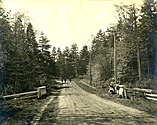Street/Place Names
Click on any letter, above, to visit specific section of Street/Place Names
PLACE NAMES
| Jimmy Chicken Island (Mary Tod Island) |
|
| Locally named after Jimmy Chicken, a Songhees native who lived on the island with his wife Jenny and sold his catch of the sea (and a few stolen chickens) to the Mount Baker Hotel. | |
| see Jimmy Chicken | |
|
Juan de Fuca (Strait of) |
|
| Named after Greek pilot Juan de Fuca, who sailed up this strait in 1592. |
|
| Regarded as myth for nearly two hundred years, the existence of this inlet was confirmed by Captain Charles William Barkley in July, 1787, who recognized it as the long lost strait of Juan de Fuca and so named it on his charts |
The History of Oak Bay Website
A CENTENNIAL LEGACY PROJECT
